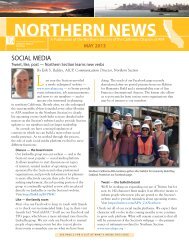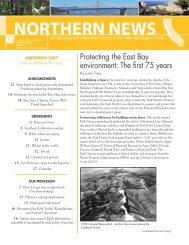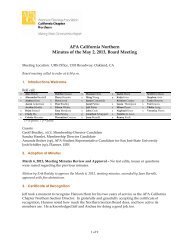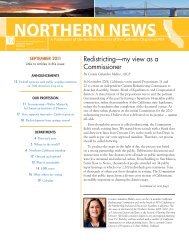Plan-it sustainably - Northern California Section
Plan-it sustainably - Northern California Section
Plan-it sustainably - Northern California Section
You also want an ePaper? Increase the reach of your titles
YUMPU automatically turns print PDFs into web optimized ePapers that Google loves.
NORTHERN NEWSA Publication of the <strong>Northern</strong> <strong>Section</strong> of the <strong>California</strong> Chapter of APAAmerican <strong>Plan</strong>ning AssociationMaking Great Commun<strong>it</strong>ies HappenNOVEMBER 2012Lessons learned from LEED to leanBy Peter PirnejadIt is time that I — having spenta considerable amount of myprofessional career promoting healthybuildings and neighborhoods — applysome of the lessons I have learned topromoting healthier people.As a mid-career professional planner, I was drawn to theidea of healthier, more sustainable buildings and to promotinggreen buildings, neighborhoods, and ordinances. I spenta considerable portion of the last decade speaking at variousconferences on this noble cause, and I continue to advocatefor sustainable development.It was coincidence that my career was entering <strong>it</strong>s midlifeas I was. I decided to challenge mortal<strong>it</strong>y by signing up formy first ironman. After a year of training and preparation,I traveled to Guerneville to try my hand at one of the hardestsingle day endurance events. Three years and four ‘ironman’slater, I hung up my wetsu<strong>it</strong>, bike, and running shoes.In the post-endorphin haze, I started thinking about howplanning and health come together. For someone to findtime in their busy working, commuting, and family life toexercise would require, I thought, a complete lifestylechange. For many, making exercise and diet one of the mainfocal points of their lives in order to avoid being countedw<strong>it</strong>h the other 65 percent of Americans who are overweight 1might seem a losing battle. W<strong>it</strong>h research that links physicalactiv<strong>it</strong>y and health outcomes, the Surgeon General’s 1996report on physical activ<strong>it</strong>y and health made clear that thestakes are life or death. 2 The good news is that people don’tneed to train for an ironman; they only need 30 minutes ofmoderate-intens<strong>it</strong>y physical activ<strong>it</strong>y most days of the week.If the opportun<strong>it</strong>ies are there, <strong>it</strong> is not hard to find, inthe course of a typical day, 30 minutes for moderatelyintense physical activ<strong>it</strong>y. Unfortunately, and to no one’ssurprise, c<strong>it</strong>ies, commun<strong>it</strong>ies, and buildings have beentrending toward encouraging convenience rather thanpromoting mobil<strong>it</strong>y. We see an epidemic of auto-orientedstreets instead of bicycle and pedestrian focus corridors;expansive landscaped setbacks and medians instead of trailsand linear parks; and elevator-centric buildings that designstairs for emergency ex<strong>it</strong>s rather than extensions of thewalker’s experience. As planners we have the abil<strong>it</strong>y tochange this trend.The sustainabil<strong>it</strong>y agenda has dominated a significantportion of the planning and building bandwidth since thelate 1990s. The agenda went from progressive to mainstreamin 2010 when the ICC published the optionalGreen Building Code. By 2011 — as the ordinance becamemandatory — <strong>California</strong> c<strong>it</strong>ies no longer had the optionto ignore sustainabil<strong>it</strong>y. And by 2014, the measures beginto affect existing buildings.How did this happen in such short order? By weaving theappropriate adjustments slowly into everyday life and vocabulary,we were able to absorb the change merely by realigningour prior<strong>it</strong>ies rather than drastically changing direction.It was determined early on that there is no need to createa whole new element of a general plan in order to considersustainabil<strong>it</strong>y; rather, the subject was infused into everypolicy of the general plan. The result was an internallyconsistent and holistic approach to sustainabil<strong>it</strong>y ratherthan an afterthought. In much the same way, wellness needsto be another lens through which we review general planpolicies to consider their health impacts. Humboldt County’sGeneral <strong>Plan</strong> does just that by applying an assessment toolnormally used in Public Health circles — the Health ImpactAssessment — to study the health implications of their longrange planning policy document. 31 Katherine M. Flegal, PhD; Margaret D. Carroll, MS; Cynthia L. Ogden,PhD; Clifford L. Johnson, MSPH. Prevalence and Trends in Obes<strong>it</strong>y AmongUS Adults, 1999–2000. JAMA. 2002;288(14): 1723–1727.http://b<strong>it</strong>.ly/PyeNve2 U.S. Department of Health and Human Services. Physical Activ<strong>it</strong>y andHealth: A Report of the Surgeon General. Atlanta, GA: U.S. Departmentof Health and Human Services, Centers for Disease Control and Prevention,National Center for Chronic Disease Prevention and Health Promotion, 1996.http://1.usa.gov/UYHJOk3 Humboldt County General <strong>Plan</strong> Update Health Impact Assessment,March 2008, 46 pp. http://b<strong>it</strong>.ly/SWLAcO(continued on page 4)





![[NAME OF EVENT] EVALUATION FORM](https://img.yumpu.com/32351925/1/190x245/name-of-event-evaluation-form.jpg?quality=85)

